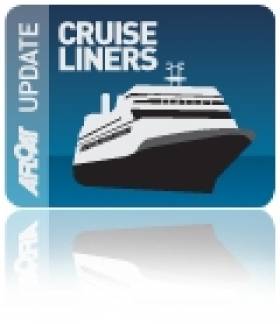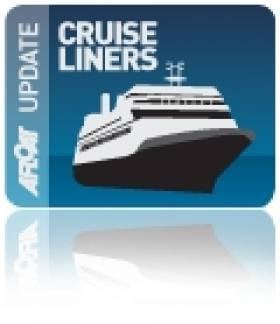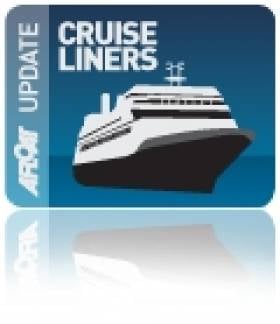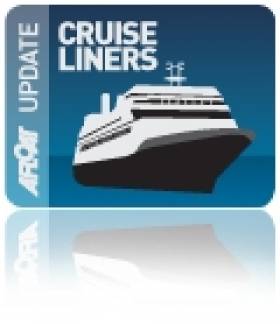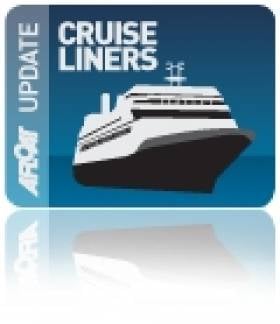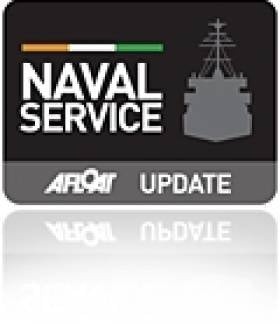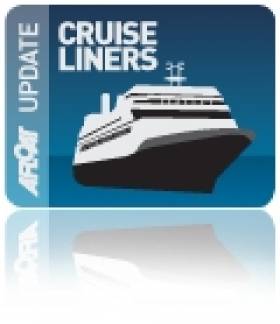Displaying items by tag: Queen Elizabeth II
Royal Yachting Association Mourns Loss of Queen Elizabeth II
The Royal Yachting Association (RYA) has issued a statement mourning the loss of its patron, Queen Elizabeth II on Thursday (8 September), sharing that it is “deeply saddened” by her passing:
Our thoughts and condolences are with The Princess Royal, RYA President, and the entire Royal Family.
Known for her sense of duty and her devotion to a life of service, Her Majesty The Queen has been an important figurehead for the UK and the Commonwealth. She has ruled for longer than any other monarch in British history, becoming a much loved and respected figure across the globe.
In 1948, Her Royal Highness Princess Elizabeth, Duchess of Edinburgh and Prince Philip, Duke of Edinburgh were listed as new members of the RYA (known then as the Yacht Racing Association). It became the Royal Yachting Association in 1952 when Sir Ralph Gore, then president, spoke of “Her Majesty’s recent command that the name of the Association will in future be the Royal Yachting Association”. He had written to the Home Secretary at the time, asking him kindly to convey to Her Majesty “our great appreciation of this command”.
The Royal Family has a long history of seafaring. Over the centuries the monarchy has sailed aboard 83 royal yachts, including the most recent, HMY Britannia, which often hosted the RYA Council meetings during Cowes Week.
In addition to her diplomatic duties on royal tours, HMY Britannia was also a vessel for family holidays. During the summer months, the Royal Family would often take off on what became known as the aptly named Western Isles tour, cruising around Scotland. The tour often included a stop off at the Castle of Mey to visit The Queen Mother before berthing in Aberdeen so that Her Majesty The Queen could travel to her favourite summer home, Balmoral.
With so many fond memories around the yacht, Her Majesty The Queen officially took her leave of it in 1997 and the vessel was placed in the port of Leith in Scotland, where it serves as a floating museum and events venue. All of the clocks on board remain stopped at 3:01, the exact time that Her Majesty disembarked for the last time.
In 1948, Bluebottle was presented to Her Majesty The Queen (then HRH Princess Elizabeth) and HRH Prince Philip as a wedding present from the Island Sailing Club of Cowes, Isle of Wight. Bluebottle is the only British Dragon to have won an Olympic medal, picking up a bronze at the 1956 Melbourne Olympic Games.
Chris Preston, chair of the Royal Yachting Association, today said: “Like so many around the world, we are deeply saddened at the loss of Her Majesty The Queen. Her patronages and charities have covered a wide range of issues, from opportunities for young people, to the preservation of wildlife and the environment. It was an honour for the RYA to host Her Majesty The Queen and The Duke of Edinburgh on a trip to Cowes in 2012, where they were introduced to a number of young OnBoard sailors who were enjoying the opportunity to try sailing and windsurfing.
“Having Her Majesty as Royal Patron, alongside the support of her husband HRH The Duke of Edinburgh as former RYA President and her daughter The Princess Royal as our current President, has undoubtedly helped us to raise awareness of our aims to increase participation in boating, to promote safety afloat and to raise sailing standards. Her Majesty will be sorely missed and we offer our deepest condolences to our president, The Princess Royal, and her family.”
Queen Elizabeth Cruise Liner Arrives off Dun Laoghaire
#queenelizabeth – Cunard's Cruise liner Queen Elizabeth, the sister ship to the Queen Mary II that visited in May, is berthed off Dun Laoghaire this morning. Passengers began disembarking shortly after 7am by tender to come ashore to see the sights of the Capital on a stunning morning on Dublin Bay.
Afloat.ie's Jehan Ashmore was one of the first on board the ship this morning that is decorated in an art deco style, reminiscent of 1930s ocean liners and will be reporting back on a tour of the ship later today.
Dún Laoghaire is the fifth port of call for the Queen Elizabeth since it set sail from Southampton a week ago on a 10-day cruise of Britain and Ireland.
The ship belongs to the world-famous Cunard Line.
Speaking after the arrival of the Queen Elizabeth, CEO of Dún Laoghaire Harbour Company, Gerry Dunne, said: "The iconic Queen Mary 2 visited Dún Laoghaire in May and, today, we are delighted to welcome her sister ship, the Queen Elizabeth. It is a tremendous boost for the Harbour to have a visit from a ship of her calibre.
"Recently, Dún Laoghaire has been designated as a centre for marine-related tourism under the National Ports Policy. We believe that cruise tourism has the potential to deliver a significant economic benefit to the town, the Greater Dublin area and the country in general. We're already hearing from businesses in town that the cruise calls have given a significant increase to the number of tourists visiting Dún Laoghaire.
"During the 2013 season, the Harbour is expecting to handle a record 14 cruise ship calls, bringing potentially up to 30,000 passengers and crew ashore. The figures are very encouraging and it augurs well for our plans to develop the Harbour as the key port for cruise visits along Ireland's east coast."
Dún Laoghaire Harbour Company is working with the Dún Laoghaire Cruise Stakeholder Group to engage in an energetic marketing campaign to enable Dún Laoghaire to tap into the lucrative cruise market. As part of the Stakeholder Group work, Dún Laoghaire Harbour Company has initiated a pre-application consultation with An Bord Pleanála under Section 37 of the Planning and Development Act, 2000, in regard to proposals for the construction of a new quay in Dún Laoghaire Harbour to cater for vessels of up to c.340m long. This will ensure that the harbour is also capable of catering for the 'new generation' of larger cruise vessels.
The Queen Elizabeth is the newest and second largest ship on the Cunard line and features eight restaurants, two theatres, three swimming pools and a games deck, together with a large spa and fitness centre, shopping arcade, libraries, bars, cafés, and a casino. The Queen Elizabeth has taken her name from the legendary Cunard Ocean Liner RMS Queen Elizabeth.
Cruiseships Great and Small Lineup for Dublin 2012
#CRUISE LINERS- Around 85 cruiseships are scheduled to call to Dublin Port in 2012, which compares closely to the same number of calls for this year's season, writes Jehan Ashmore.
First to start the season will be Grand Princess, which has the accolade of being the inaugural cruiseship to enter the port with a tonnage surpassing the 100,000 gross tonnes. The milestone was marked by the Princess Cruises call in 2004.
As usual with that number of cruise-callers, the variety of vessels will range from the small to the very large. A prime example is the diminutive expedition cruiseship Quest (1,180 tonnes) and at just under 50-metres long has just over the same number in passenger capacity.
In complete contrast to the ice-strenghtened Quest is the giant Caribbean Princess, a larger sister of Grand Princess, can accommodate over 3,000 passengers and she is make several calls.
Noble Caledonia which has been operating Quest (PHOTO) on successful seasons in Scotland, is to embark on itineraries next season to Ireland, England and Wales for the first time. Her half-sister Ocean Nova has called to Dublin on previous occasions.
For only the second time, Queen Elizabeth is due return to the capital (for report click HERE) in late Summer and in the same week, Hebridean Princess is also scheduled to call. The later vessel in recent years was chartered to Queen Elizabeth II, for a cruise off the Scottish Isles. To read more on the small ship's visit to the port earlier this year click HERE.
Queen Elizabeth's Chartered Cruiseship on Three-Day Visit to Dublin
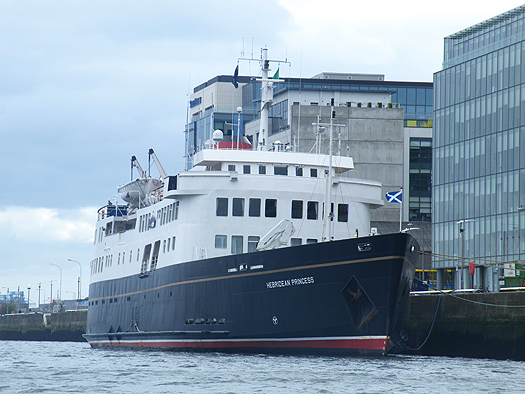
Operated by Hebridean Island Cruises, the 5-star vessel which is for only 50 guests, has a reputation for exceptional service, fine dining and has a crew of 38. Accommodation is in thirty spacious, elegant and well-appointed cabins. On Princess Deck is located 'The Isle of Arran' (for deck plans click HERE) Suite which at 340sq ft is the largest and most expensive. The suite comprises a large separate dayroom, a spacious bedroom and a luxuriously equipped Victorian-style marble bathroom. In addition 10 cabins are designed especially for the single traveller. She has appeared in 1st place in UltraTravel Magazine's "10 Coolest Cruises"
Normally the Glasgow registered vessel operates throughout the Scottish highlands and islands, to lochs and remote mainland locations made accessible due to her small size. It is in these same waters that the Hebridean Princess has sailed in another guise as the humble car-ferry Columba (photos) for Caledonian MacBrayne. She was built in 1964 by Hall Russell, Aberdeen and served in this role until 1989 when she was sold and underwent an extensive conversion for the ultra-luxury cruise market.
Her three-day stay to Dublin is part of a Grand Celtic Cruise which started in Cardiff and which will include a call to Carlingford Lough tomorrow, followed by Strangford Lough, Bangor, Ballycastle, the Scottish isles of Jura and Crinan before disembarking in Oban, her home-port. The 10-night cruise inclusive of three-gala dinners cost €4,195 per person for a double cabin and €6,292 per person in a single-cabin.
A decade before Columba was launched, the Royal Yacht Britannia (5,682 tonnes) was commissioned in 1954. She was laid-down two years previously at John Brown & Co. Ltd, Clydebank and the year before she entered service she was launched by HM Queen Elizabeth II. For over four decades she served as the royal yacht until decommissioned in 1997. Her final foreign mission was to convey the last governor of Hong Kong and Prince of Wales from the former colony after its handover to China. She is now permanently moored as an exhibition ship in Edinburgh (Leith) for details click HERE.
Earlier this month Queen Elizabeth's namesake the 2010 built Cunard Line cruiseship Queen Elizabeth made her maiden Irish call to Dublin followed by Cork (Cobh). To read more on Dublin call click HERE and for Cork (Cobh) click HERE.
- Dublin Bay
- Dublin Port
- Dublin Docklands
- Cobh
- Cruise Liners
- Ports and Shipping
- Queen Elizabeth II
- Cruiseships
- Cunard Line
- The Convention Centre
- Cruise news
- Hebridean Princess
- Hebridean Princess Cruises
- Columba ferry
- Caledonian MacBrayne
- Hall Russell Shipyard
- Royal Yacht Britannia
- Hong Kong handover
- Prince of Wales
- Royal Yacht
Cunard Line Flagship Queen Mary 2 Calls to Cobh
The current liner (QM2) can carry 2,620 passengers and a crew of over 1,200 on a vessel is the longest, tallest and widest of any passenger liner built. The luxury liner has private balconies for nearly 80 per cent of cabins and has an art collection worth £3.5m. To complement these works of art there is the first 'floating planetarium', the largest library at sea, boasting 8,000 hardbacks and also the largest ballroom to grace a ship on the oceans.
Queen Mary 2 was short-listed to be built in Belfast at the Harland & Wolff shipyard, but the contract went to Chantiers d'Atlantique, St. Nazaire on the west coast of France.
Her first visit to Irish waters occurred when she anchored off Dunmore East in 2005, the liner had arrived overnight on a passage from her homeport of Southampton and was on a nine-day cruise of British, Irish and Baltic state ports.
Today's Cobh visit of the 345m long Queen Mary 2 coincided with Ocean Countess, a former 'Cunarder', which is also in the port. The 163m vessel was built in 1976 and launched as their Cunard Countess. She weighs 17,593grt and has a 800 passenger capacity. Last year she joined Cruise & Maritime Voyages (CMV) fleet under charter from Majestic International Cruises Group.
Also at work in Cork Harbour was the excursion vessel Spirit of the Isles which apart from operating River Lee sight-seeing cruises between Cork city-centre and Cobh at the weekends, is running a charter cruise this afternoon to Spike Island. For information about sightseeing trips and chartering click HERE.
Queen’s Namesake to Retrace Royal Visit
The 90,901 gross registered tonnes cruise ship is to depart her Hampshire homeport, where she is to similarly follow the monarch in that she is scheduled to make a port of call to Dublin first on 9 September and make a call to Cork afterwards.
With a length of 295m / 965-feet the vessel will dock in the centre of the capital port before she sails overnight to make a morning arrival at Cobh, the dedicated cruise terminal for the Port of Cork. She is scheduled to stay at the Cork Harbour town formerly named Queenstown until a 17.00 hour departure.
Her visit coincides with Cork Harbour Open Day, where visitors can view the impressive vessel from the quayside, for more details visit www.corkharbour.ie
Incidentally her near-sister Queen Victoria also called to Dublin in May and the remaining vessel of the Cunard fleet, the 'flagship' liner Queen Mary 2 is also to dock in Cobh three days later after Queen Elisabeth's visit.
- Cobh
- Cork Harbour
- port of Cork
- Cruise Liners
- Cork Harbour Open Day
- Ports and Shipping
- Cobh Cruise Terminal
- Queen Elizabeth II
- Cork Harbour News
- Port of Cork Company
- Cunard Line
- queen victoria
- Port of Cork News
- Queen Elizabeth
- Queen Mary 2
- QM2
- Cruise Liner news
- TransAtlantic Liners
- Cruise ships
- Irish cruiseship calls
- Queen's visit to Ireland
- QV
- QE
- Cunarders
- Cobh Cunarders
- Cobh cruise calls
- Cunard liners
- Cunard cruiseships
- Royal visit to Ireland
- Cobh cruise liners list
Increased Naval Presence for Queen’s Visit
The most modern naval vessel of the eight-strong fleet the LÉ Niamh (P52) is an offshore patrol vessel (OPV) which is equipped with a bow-mounted 76mm gun. To see the crew undertake exercise-drills of the gun, watch the video below.
Cork's Cruiseship's Call Schedule 2011
The inaugural call for this season was made last Monday by Cunard Line's Queen Victoria (90,049grt) and the four year-old vessel is to return for another visit on 5 May. Her slighty larger sister Queen Elizabeth (90,400grt) will make her maiden 'Irish' port of call on 10 September.
Last Autumn the 2,092 passenger cruiseship newbuild was 'floated-out' of the building dry-dock at Fincantieri's Monfalcone shipyard in Italy. At 294m long her hull is derived from the 'Vista' class series built for Carnival Corporation, owners of the Cunard Line.
Four days later the Cunard 'flagship' Queen Mary 2 (QM2) will also make an appearance. The 148,528grt French built vessel is the only designated cruise-liner in the world, the title was handed on from her predecessor, Queen Elizabeth II (QE2).
Throughout the career of the iconic liner, she made several calls to Cork (Ringaskiddy) while employed on the Atlantic 'liner' service between Southampton and New York.
On her farewell cruise QE2 made her first and only call to Cobh in 2008, the 70,327grt ship was meant to stay for a standard day-long visit but due to strong windy weather conditions in Cherbourg, she was prevented from docking and spent an un-scheduled overnight stay in the picturesque location.
The scheduling of all three 'Cunarders' to Cobh will be a first for the Port of Cork. Asides the Italian-built trio, there will be plenty more cruise callers lined up for the season, notably the Independence of the Seas, the largest cruiseship caller to an Irish port.
The Finnish built giant weighs 154,407 grt (some 6,000 tonnes larger than the liner QM2) and can carry 4,375 passengers.
Another large visitor will be the Azura at 115,055grt which can handle 3,100 passengers. She is the built to a design based from the 'Grand' class ships commissioned for Carnival Corporation's which also owns Princess Cruises.
The value of the cruiseship sector business to the island of Ireland this year is valued at €60m. The list below is a schedule of cruiseship calls to Cork Harbour (Cobh, Ringaskiddy and Cork city-centre quays).
Please note information is based in the order of ship's name first, passenger capacity (PAX), arrival date (time), location of berth and lastly departure date (time). For the most up-to-date information please refer to the Port of Cork Company website cruise call list.
ATHENA 580 Apr 27th at 08:00 Cobh Cruise Terminal
CELEBRITY ECLIPSE 3129 Apr 30th at 14:00 Cobh Cruise Terminal
May 1st at 16:00
INDEPENDENCE OF THE SEAS 4375 May 1st at 17:00 Cobh Cruise Terminal
May 2nd at 18:00
CELEBRITY ECLIPSE 3129 May 4th at 14:00 Cobh Cruise Terminal
DISCOVERY 689 May 4th at 07:00 Ringaskiddy DWB May 4th at 22:00
QUEEN VICTORIA 2000 May 5th at 20:02 Cobh Cruise Terminal
May 25th at 18:00
EMERALD PRINCESS 3592 May 6th at 08:00 Cobh Cruise Terminal
May 6th at 19:00
LE BOREAL 260 May 9th at 07:00 Cobh Cruise Terminal May 9th at 17:00
GRAND PRINCESS 3300 May 15th at 06:00 Cobh Cruise Terminal
May 15th at 17:00
COSTA DELIZIOSA 2826 May 17th at 07:00 Cobh Cruise Terminal
May 17th at 19:00
CROWN PRINCESS 3114 May 24th at 07:00 Cobh Cruise Terminal
May 24th at 17:00
ROTTERDAM 1668 May 26th at 07:00 Cobh Cruise Terminal
May 26th at 17:00
SILVER WHISPER 1668 May 28th at 09:00 Cobh Cruise Terminal
May 28th at 23:00
LE DIAMANT 200 Jun 22nd at 06:00 Cobh Cruise Terminal
Jun 22nd at 19:00
ASTOR 656 Jun 27th at 06:00 Ringaskiddy DWB
SILVER CLOUD 296 Jun 27th at 07:00 Cobh Cruise Terminal
Jun 27th at 19:00
MINERVA 352 Jul 1st at 07:00 Cobh Cruise Terminal
LE DIAMANT 200 Jul 7th at 06:00 North Custom House Quay
Jul 7th at 23:30
AURORA 1950 Jul 7th at 11:30 Cobh Cruise Terminal
Jul 7th at 23:00
ATHENA 580 Jul 15th at 08:00 Cobh Cruise Terminal
Jul 15th at 17:00
SILVER CLOUD 296 Jul 18th at 07:00 Cobh Cruise Terminal
Jul 18th at 19:00
SPIRIT OF ADVENTURE 470 Jul 19th at 06:00 North Custom House Quay
Jul 19th at 18:00
ROTTERDAM 1668 Jul 19th at 07:00 Cobh Cruise Terminal
Jul 19th at 17:00
AZURA 3100 Jul 19th at 08:00 Ringaskiddy DWB
Jul 19th at 18:00
DAWN PRINCESS 2342 Jul 24th at 06:00 Cobh Cruise Terminal
Jul 24th at 17:00
CROWN PRINCESS 3114 Jul 26th at 07:00 Cobh Cruise Terminal
Jul 26th at 17:00
MARINA- Jul 27th at 07:00 Cobh Cruise Terminal
Jul 27th at 18:00
AIDABLU 2580 Aug 11th at 07:00 Cobh Cruise Terminal
Aug 11th at 18:00
MAASDAM 1613 Aug 13th at 06:00 Cobh Cruise Terminal
Aug 13th at 15:00
SEVEN SEAS VOYAGER 730 Aug 17th at 07:00 Cobh Cruise Terminal
Aug 17th at 15:00
CROWN PRINCESS 3114 Aug 18th at 07:00 Cobh Cruise Terminal
Aug 18th at 17:00
LE DIAMANT 200 Aug 19th at 06:00 Cobh Cruise Terminal
Aug 19th at 23:30
CLIPPER ODYSSEY 128 Aug 19th at 07:00 Cobh Cruise Terminal
Aug 19th at 21:00
ATHENA 580 Aug 22nd at 07:30 Cobh Cruise Terminal
Aug 22nd at 17:00
AIDABLU 2580 Aug 25th at 07:00 Cobh Cruise Terminal
Aug 25th at 18:00
LE DIAMANT 200 Aug 26th at 06:00 Cobh Cruise Terminal
Aug 26th at 23:00
ARCADIA 2388 Aug 29th at 07:00 Cobh Cruise Terminal
Aug 29th at 17:00
AZAMARA JOURNEY 702 Aug 31st at 08:00 Cobh Cruise Terminal
COSTA DELIZIOSA 2826 Sep 1st at 07:00 Cobh Cruise Terminal
Sep 1st at 18:00
LE DIAMANT 200 Sep 3rd at 07:00 North Custom House Quay
Sep 3rd at 17:00
PRINSENDAM 843 Sep 3rd at 09:00 Cobh Cruise Terminal
Sep 3rd at 18:00
DISCOVERY 689 Sep 4th at 08:00 Cobh Cruise Terminal
Sep 4th at 18:00
SILVER CLOUD 296 Sep 5th at 07:00 Cobh Cruise Terminal
Sep 5th at 18:00
JEWEL OF THE SEAS 2500 Sep 6th at 08:00 Cobh Cruise Terminal
Sep 6th at 16:00
SILVER WHISPER 388 Sep 10th at 06:00 Cobh Cruise Terminal
Sep 10th at 18:00
QUEEN ELIZABETH 2092 Sep 10th at 08:00 Ringaskiddy DWB
Sep 10th at 17:00
OCEAN COUNTESS 884 Sep 14th at 06:30 Ringaskiddy DWB
Sep 14th at 16:30
QUEEN MARY 2 2592 Sep 14th at 08:00 Cobh Cruise Terminal
Sep 14th at 17:00
OCEAN COUNTESS 884 Sep 16th at 07:30 Cobh Cruise Terminal
FRAM 500 Sep 28th at 07:00 Cobh Cruise Terminal
Sep 28th at 18:00
SAGA RUBY 668 Dec 15th at 07:00 Cobh Cruise Terminal
Dec 15th at 23:00
- Cruiseships
- Cruise Liners
- Cork Harbour
- Cork Harbour News
- Port of Cork Company
- Port of Cork News
- Cobh
- Cobh Cruise Terminal
- Cunard Line
- Carnival Corporation
- Princess Cruises
- queen victoria
- Queen Elizabeth
- Queen Elizabeth II
- QE2
- Queen Mary 2
- QM2
- Independence of the Seas
- Royal Carribean Cruise Line
- RCCL
- Fincantieri
- Grandclass
- Vistaclass
- Ports and Shipping News
Cadets Celebrate 150 Years with Royal Visit
The Cadet Forces in Northern Ireland celebrated their 150th anniversary this year. At a reception to mark the occasion which was held at Hillsborough Castle, Queen Elizabeth II accompanied by the Duke of Edinburgh met the various cadets forces to include the Sea Cadets Corps.
The Sea Cadet Corps are part of the Northern voluntary organisation whose purpose is to develop, in youth, the attributes of leadership,active citizenship and physical fitness within a challenging and fun environment.
In total the organisation has around 3,600 cadets and 500 Cadet Force adult volunteers make up the four cadet forces, including The Sea Cadet Corps, The Army Cadet Force, The Air Training Corps and the Combined Cadet Force whose 1,200 cadets.
The cadets are located at the Bangor Grammar School, CampbellCollege, Foyle and Londonderry College, Royal Belfast Academical Institution and The Royal School Armagh.
.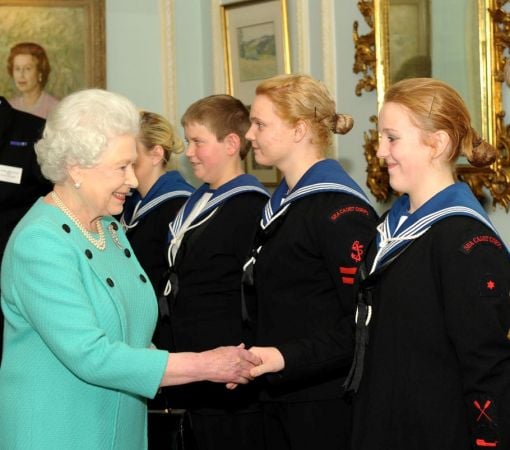
Coleraine Cadet Eimilie Sherman shakes hands with Her Majesty.
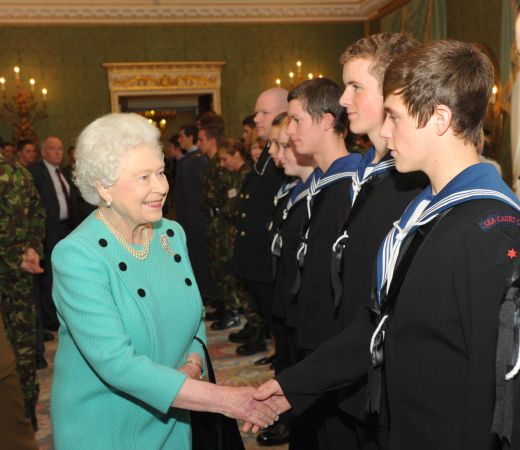
Nick Johnston from Antrim enjoys a chat with Her Majesty.
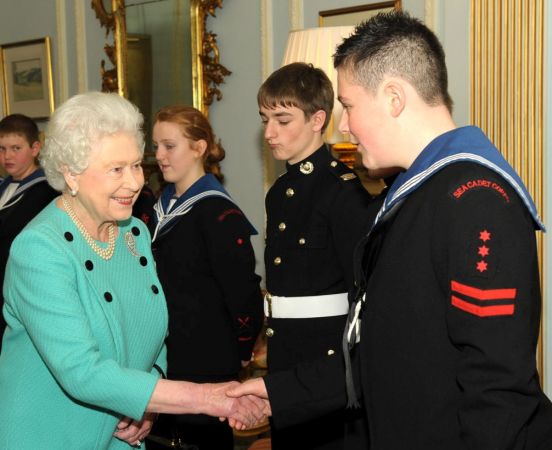
A moment to treasure for Aaron Brogan
.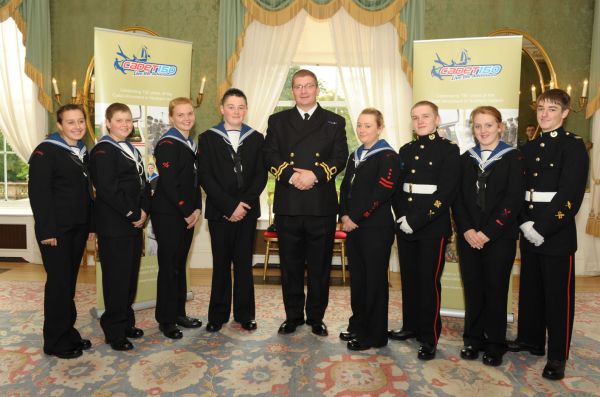
Preparing for the visit are, from left, Rebecca Abram from Larne; Stephen Baird from Ballymena; Andrea Hanna from North Belfast; Luke Douglas from County Down; Lieutenant Robert McLennan from Newtownabbey; Eimilie Sherman from Coleraine; Aaron Brogan from Bushmills; Emma Hobbs from Larne and Ronan Sherman from Coleraine.
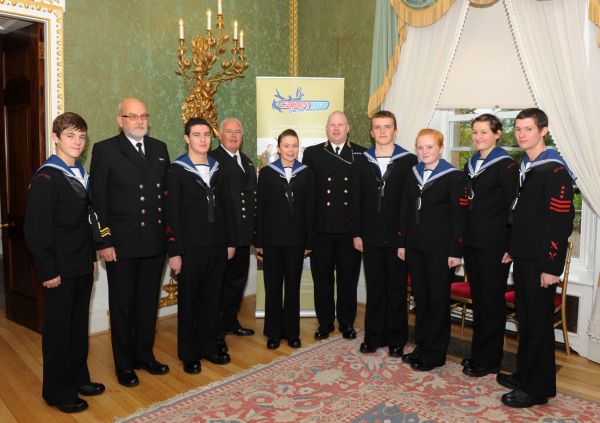
Looking suitably 'ship shape' are, from left, Nick Johnston from Antrim; Lieutenant Commander Ross Mulholland from Glenavy; Johnny McAllister from North Belfast; Lieutenant Commander Bill Keery from Bangor; Alexandra McQuisten from North Belfast; John Kinner from Bangor; Lewis Tipping from North Belfast; Nikita McCoubrey from North Belfast and twins Louise and Thomas Potter from Portaferry.


























